Doctor Who’s Best Episodes: The 1970s Era
Jon Pertwee and Tom Baker take over the TARDIS for an era that contains some of Doctor Who's finest stories.
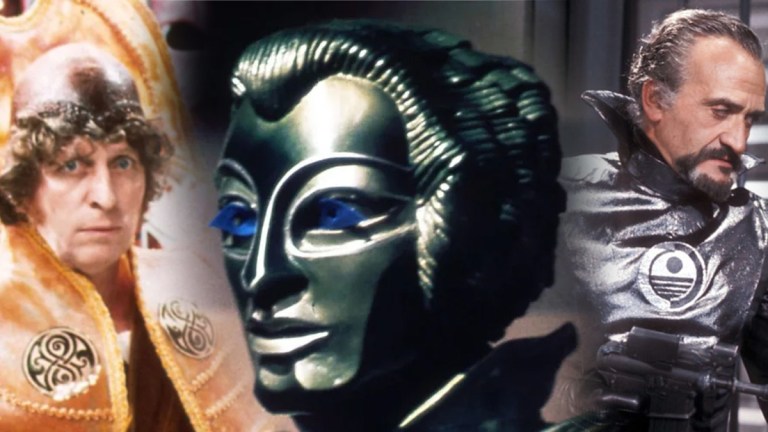
In terms of baseline quality, the Seventies is probably the most consistent Doctor Who has been until the 21st Century. There’s a classic story in nearly every season, and fondly-thought-of stories throughout. The long-list for this one was very long, the certainty of not including someone’s favourite even more certain than usual.
Producer Barry Letts and Script Editor Terrance Dicks took a show with the potential for cancellation and moved it from Quatermass homage to the cosiest of nightmare fuel: a family show on and off-screen with the reassuringly haughty Jon Pertwee ruffling hearts and minds at the head of a regular ensemble cast.
After five seasons the family was breaking up, and the show was revitalised by incoming Producer Philip Hinchcliffe and Script Editor Robert Holmes. Aiming at an older audience (Holmes in The Daily Express in 1977: ‘I wouldn’t let any child under ten see it’) they put more weight behind the horror and looked to a mix of classic science fiction stories and genre movies for inspiration. After complaints and a budget overspend, Hinchcliffe moved on and was replaced by Graham Williams and several Script Editors (most famously Douglas Adams). Williams was instructed by the BBC to tone down the violence and make the show more child friendly amid financial restrictions, with Script Editor Anthony Read being influenced by mythology and the classics. The show ramped up two weapons it always had in its armoury: wit and rage.
10. Doctor Who and the Silurians (Season 7, 1970)
Written by Malcolm Hulke. Directed by Timothy Combe.
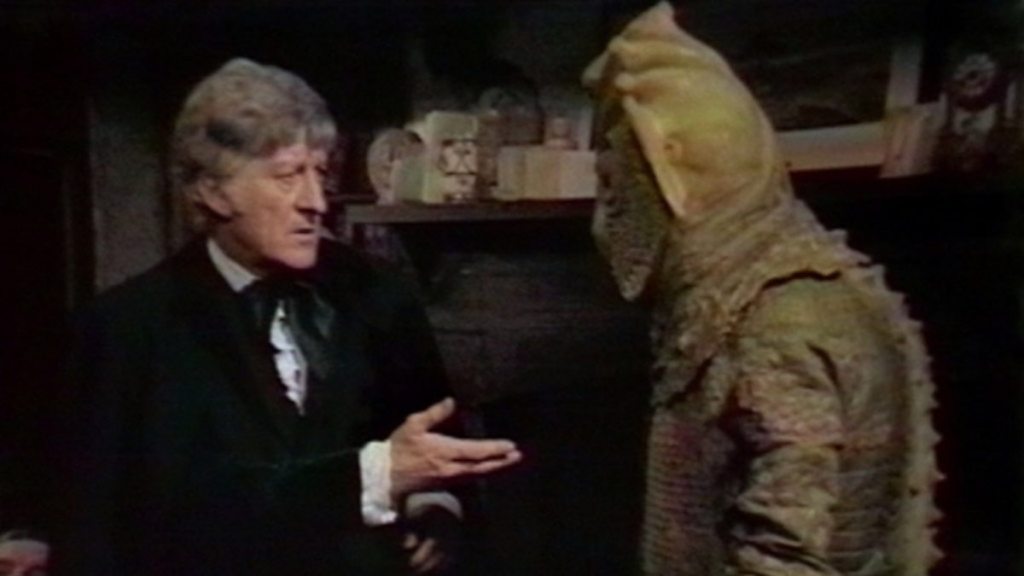
In which an underground cyclotron facility is built in a cave system containing Silurians: the inhabitants of Earth before humanity evolved from apes. Both sides have their aggressors and mediators, but is this going to end in peaceful settlement or absolute carnage?
The Pertwee era has issues with story padding. This isn’t merely people from 2022 looking back and saying ‘Isn’t this slow?’ – when Robert Holmes took over as script editor in 1974 he reduced the number of six-part stories and tweaked the ones the show did make so they functioned like a two-parter and a four-parter. The capture/escape cliché discussed below under ‘Frontier in Space’ was a frequent offender. For Season 7, the new production team of Barry Letts and Terrance Dicks inherited their predecessor’s even longer stories (the series consisting of a four-parter followed by three seven-episode stories). These three stories needed a lot going on across their unusual length. ‘Inferno’, another great story from this season, had its parallel universe storyline, whereas ‘The Silurians’ has the titular race unleash a deadly plague through the medium of Geoffrey Palmer.
It’s a horrifying sequence, filmed on location in London, that culminates in people dropping dead in Marylebone Station and Palmer’s character staggering and slithering down some railings as he succumbs. It’s enough to make you flee to Durham.
More than a merely impressive horror segue, ‘The Silurians’ features the Doctor at his most curious and furious: the scene where the Doctor first meets a Silurian is notable for Pertwee’s gentle, inquisitive tone giving way to a desperate plea for accord; this is a fantastic moment for the Third Doctor, a far cry from his more typically glib dismissals of other people’s feelings.
The Silurians themselves, despite the interesting concept of them having equal if not greater claim to Earth, are thinly sketched and ultimately reduced to more generic antagonists, but the human supporting cast is rich enough to support a soap opera (I know no one is going to commission a spin-off set in a nuclear-powered cyclotron facility – not least because pretty much all the speaking characters are killed – but it would have given The Day Today’s peerless ‘The Bureau’ a run for its money).
With its plague storyline, the story expands outwards from its initial setting before settling back there for the finale, which is rightly praised for the Doctor’s moral outrage at the Brigadier blowing up the Silurian base. In isolation it’s a great moment, although as it was a late addition to the script it’s not something that’s built on in later episodes. This is a huge shame, but on its own merits ‘The Silurians’ is a smart idea realised with strong characters, plenty of conflict, claustrophobia and paranoia. It’s also got some of the most intense death scenes in the show’s history.
9. Frontier in Space (Season 10, 1973)
Written by Malcolm Hulke. Directed by Paul Bernard.
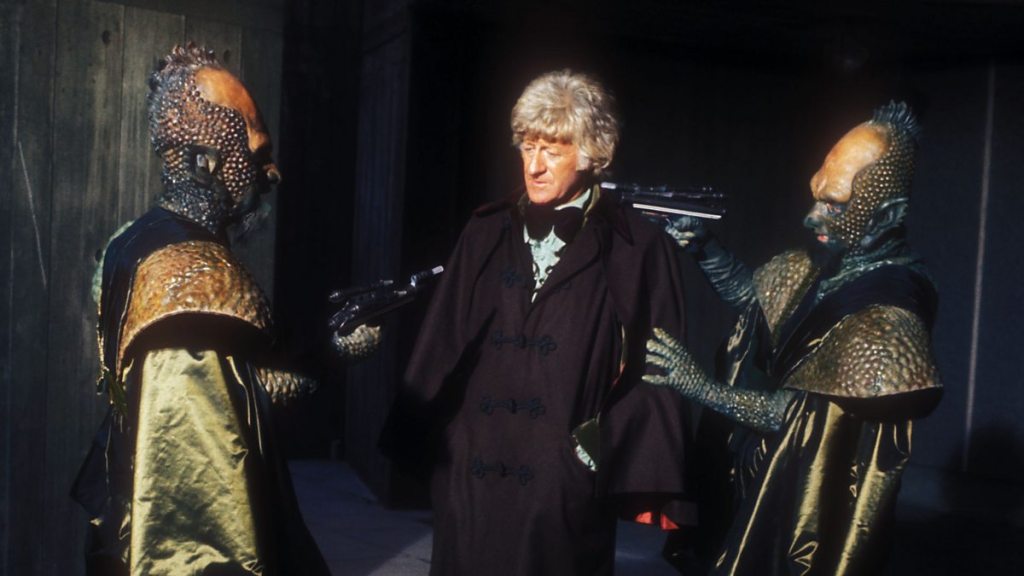
In which the Doctor and Jo find themselves embroiled in the simmering diplomatic tensions between the Earth and Draconian empires, and start to suspect the situation is being engineered by a third party.
This story should not work as well as it does. It’s rife with cliché. It’s a Third Doctor story that goes on a bit, has the Master turn up halfway through to give it a boost, and features a lot of capture/escape/recapture/escape again shenanigans where people accuse the Doctor of being an enemy spy. ‘Frontier in Space’ overcomes these issues by simply being relentlessly entertaining, the dialogue lifting the stock situations and occasionally subverting them. In short: writer Malcolm Hulke is brilliant at character. Even with something less fun like ‘Colony in Space’, the individual characters stand out.
Hulke regularly moves the action to new locations to introduce new characters. What might have been padding becomes world-building. Crucially he doesn’t just play the hits with the characters, he uses them to show development: when the Master tries to hypnotise Jo Grant – as he did in their first story ‘Terror of the Autons’ – she has learned how to resist. When asked to provide cover for subterfuge, Jo starts complaining about working at UNIT, and it’s not entirely clear whether she’s joking or not. It’s both entertaining, confounding audience expectations while showing new facets to the character and showing how far she’s come since we first met her.
Roger Delgado, in his last story playing the Master, doesn’t have much in the way of character progression but he’s still a joy to watch here. Indeed part of the joy in this one is the blend of familiarity and novelty: we have three characters we’re familiar with bickering and bantering but the story doesn’t simply trade on that familiarity. It’s like the theory behind salted caramel: comfort food, but with these little moments that just elevate it.
8. The Pirate Planet (Season 16, 1978)
Written by Douglas Adams. Directed by Pennant Roberts.
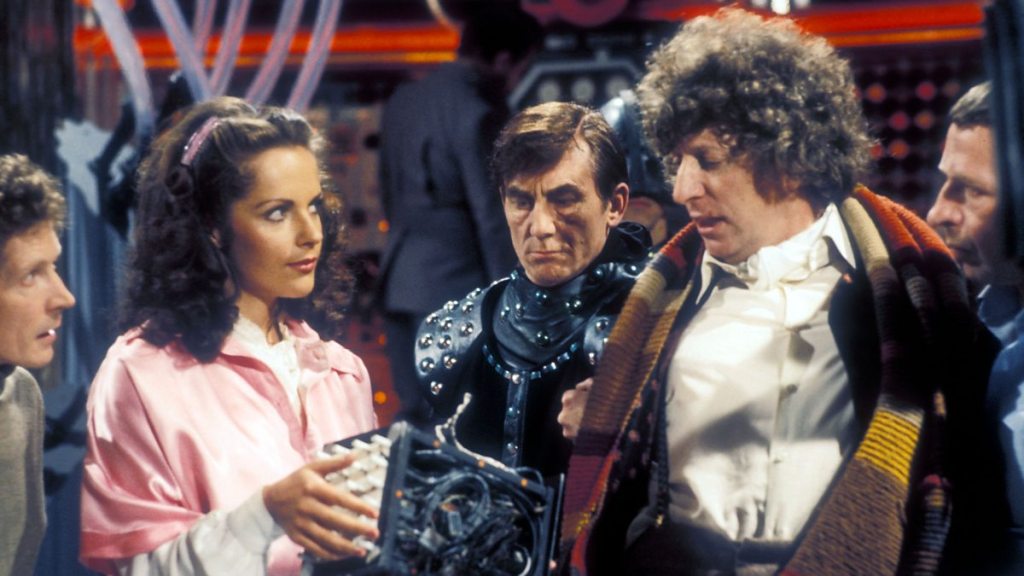
It’s been written about in more detail here, but Douglas Adams’ debut for the show is surprisingly angry beneath all the whimsy. Adams contributed material to Monty Python’s Flying Circus and worked with Graham Chapman, and so pushing the mundane into the realm of absurdity (or indeed, showing the mundane up to be absurd) was unsurprisingly a hallmark of his writing. Doctor Who was a good fit for Adams because it thrives on such juxtapositions and – as his other work attests – he clearly knew his Science Fiction. Equally though Doctor Who was a good fit for Adams. Constrained by what Iain Banks called Doctor Who’s need to put all the toys back in the box, this gave the absurdity a positive resolution: in Hitchhikers and Monty Python there was an increasing tendency towards nihilism. ‘The Pirate Planet’ does not go that way.
It is also, as you’d expect, very silly, funny and arch. Bruce Purchase’s Pirate Captain is simultaneously a ridiculous blustering figure and extremely dangerous (as ridiculous blustering figures in positions of power are) and his sidekick Mr Fibuli is both a hapless punchbag and venal adjutant. The Captain’s sadness over Fibuli’s death is strangely touching. He also has a robot parrot that K9 fights in an extremely mid-paced laser battle and bellows things like ‘By the horns of the prophet Balag, speak!’
Yet it also sees a staggering death toll with a play on words: it isn’t merely that a Captain with a parrot runs Zanak, it’s that the planet itself is engaged in the act of piracy. Not the people, they meekly cheer their many golden ages without questioning where this wealth comes from, but Zanak materialises around other planets and drains them of resources. It transpires that this is to keep an ancient monarch alive while she’s on the brink of death. The allegory is not subtle but it is potent.
And this also produces one of the strongest moments of outrage in the Doctor the show has seen, as Baker seems both genuinely sad and angry before finally snapping. It’s simply a brilliant moment as the comedy drops away, providing a sheer contrast as the ideas behind them coalesce into a serious punchline. And then ‘The Pirate Planet’ ends, not with a joke about the essential meaningless of existence or the destruction of Sixties’ ideals aka Hitchhikers: the inhabitants of Zanak blow up the antagonists’ base, and the Doctor walks away punching the air. This is Doctor Who. The Vogons do not win in Doctor Who.
7. The Green Death (Season 10, 1973)
Written by Robert Sloman and Barry Letts. Directed by Michael E. Briant.
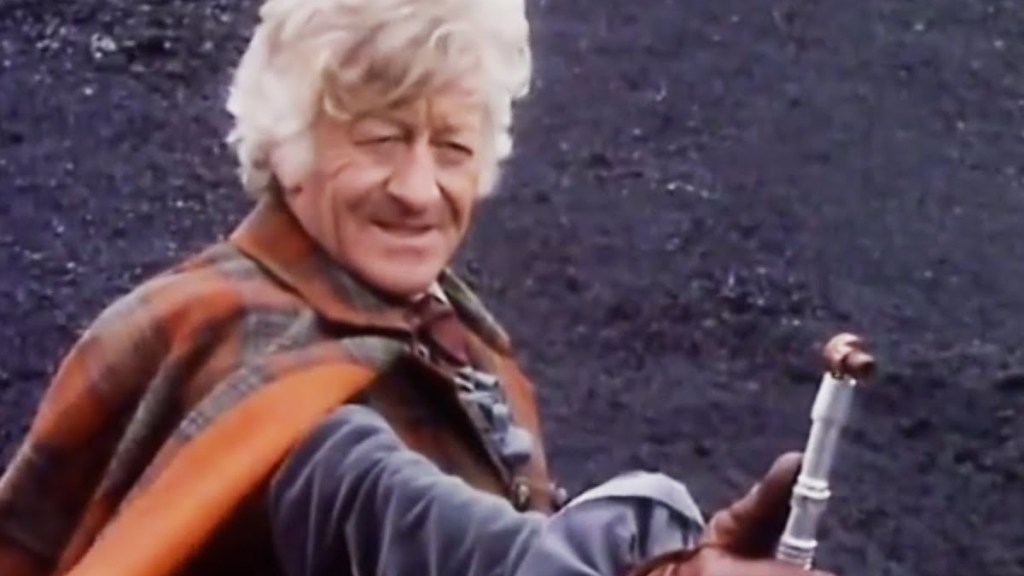
One of the stories that comes to mind in the UK’s folk memory of Doctor Who: it’s the one with the maggots (and at some point someone will get round to listing every single Doctor Who story in the style of Friends episode titles).
‘The Green Death’ is an eco-parable about how it would be bad for the environment if toxic sludge turned maggots into big green death machines. It isn’t subtle about its environmental concerns but it at least represents its ideals through character as well as dialogue, emphasised by the Doctor siding with the environmentalists. Indeed, Professor Clifford Jones – the most vocal of the environmental group – is described by Jo Grant as being like a younger Doctor. This is a cause the show is advocating loudly, while also breaking the Doctor’s hearts as he realises Jo is going to leave. Here we have a famously melancholy scene of the Doctor driving away, alone, from Jo and Cliff’s engagement announcement at the end of the story.
On top of containing images and ideas that were seared into the brains of millions, ‘The Green Death’ also contains one of the best villain and henchman combos: Stevens (Jerome Willis) is the director of Global Chemicals and the main antagonist for much of the story, occasionally referring to his unseen boss. This is revealed to be a computer called B.O.S.S. (Biomorphic Organisational Systems Supervisor), who is linked to Stevens and becomes obsessed with human irrationality. The genius move here is to have B.O.S.S. (voiced by John Dearth) mocking Stevens, giving them a put-upon bickering relationship containing digs like ‘Ah, Stevens, the adrenaline flowing nicely? Living dangerously? That’s how you get your kicks, like the good little Nietzschean you are’. It’s not entirely dissimilar to the relationship between Greg Davies and Alex Horne on Taskmaster, and I love it.
6. The Deadly Assassin (Season 14, 1976)
Written by Robert Holmes. Directed by David Maloney.
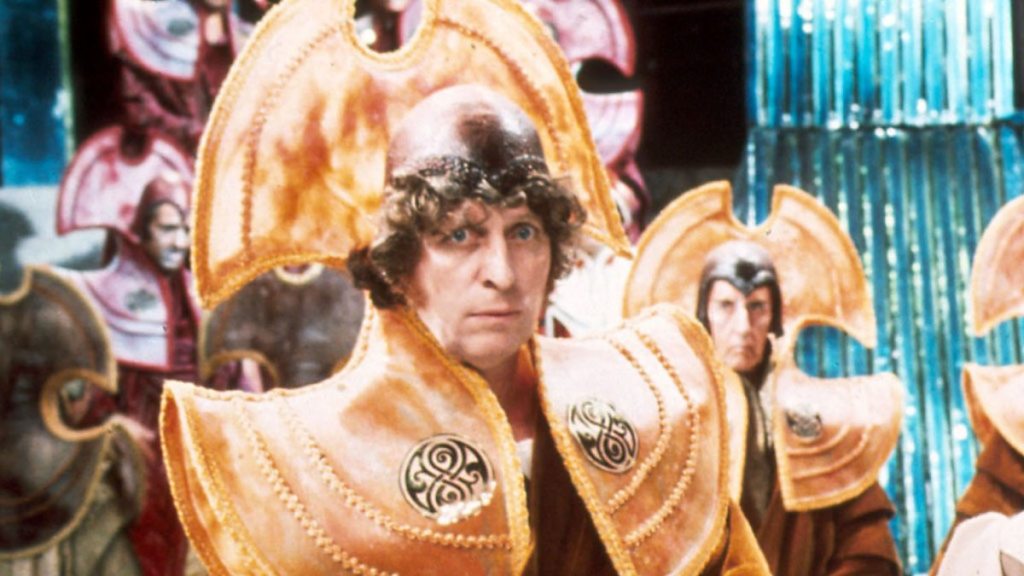
The first story to really delve into Gallifrey and the Time Lords is a Manchurian Candidate-inspired tale of assassinations, alternate realities and forgotten histories as part of a plot by a dying and skeletal Master (Peter Pratt) to restore himself to life. The Doctor is recalled to Gallifrey and, having said goodbye to Sarah-Jane, has a premonition of the President being assassinated. Gallifrey feels like a parody of Oxbridge and elite British society with its rituals and robes, old men grumbling about their hips and an acquaintance of the Doctor doing Nicholas Witchell-esque news segments. Then the Doctor discovers someone is setting him up, and finds the Master has managed to outwit most of Gallifreyan society by reading some history books. The legends that people know and accept as background hum are grounded in historical fact. There’s a throwaway joke about there being a ‘Celestial Intervention Agency’ that was taken up by spin-off novelists. In contrast to what’s gone before, Robert Holmes has set up a whole new world, a new fantastic point of view. No one to tell us no, or where to go, or say we’re only dreaming – which brings us to the Matrix.
On top of almost casually rewriting the lore to suit this one story, Holmes also wrote in the Matrix – a depository of knowledge filled with the memories of dead Time Lords – that the Master and his henchman can use to create virtual realities full of images that would terrify children and/or Mary Whitehouse. Moving from political thriller to tense adventure, the main letdown is the ending (where the Master sets his laser to stun for no reason and then there’s a medium sized grapple above as sheer a drop as a BBC studio could manage) which doesn’t live up to the rest of the story, but there’s such dark wit and invention at play here it’s hard not to be impressed. ‘The Deadly Assassin’ proves you can introduce a massive retcon about regeneration that makes fans absolutely furious, with the Master leading the Doctor a merry dance through the Matrix, while also making it entertaining.
5. Horror of Fang Rock (Season 15, 1977)
Written by Terrence Dicks. Directed by Paddy Russell.
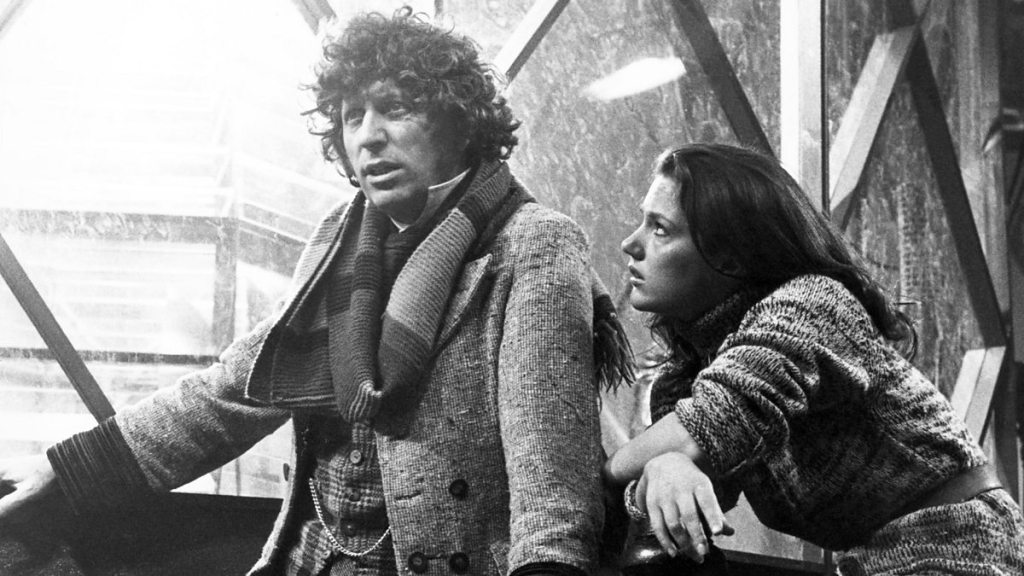
In which the Doctor and Leela arrive on the titular island, populated only by three lighthouse keepers and a shapeshifting monster intent on murdering everyone.
‘Horror of Fang Rock’ is a fantastically tense and morbid thriller, punctuated with occasional bursts of delirious comedy – most memorably when Leela berates the aristocrats who have crashed their yacht at knifepoint by yelling ‘You will do what the Doctor instructs or I will cut out your heart’ (that Leela actually works as a character is at least 70% down to Louise Jameson’s performance) or the Doctor announcing they’re under attack and will probably be dead by morning with a broad grin on his face.
Writer Terrence Dicks decided to use Rutans as the antagonists here – the previously merely-mentioned enemies of the Sontarans – and reasoned that unlike their cloned and identical nemeses the Rutans would be shapeshifters, green and blobby in their true form. This means the Rutan can break in, kill and hide. It’s a little bit like The Thing with a U certificate, as it ruthlessly cuts down the supporting cast of well-sketched lighthouse keepers, sailors and aristocrats. Director Paddy Russell is extremely good at implying horror and (as with another contender for this list, ‘Pyramids of Mars’) gets a good performance out of Tom Baker, who knows when to suddenly take things seriously.
Terrence Dicks’ best solo script for the show is another demonstration of how Doctor Who is about stories colliding: the supporting cast here could have their own drama unfolding without a Doctor Who story arriving and getting in the way. The best stories have this richness in their supporting characters, where you’d be interested in watching them even if they weren’t in Doctor Who.
4. Carnival of Monsters (Season 10, 1973)
Written by Robert Holmes. Directed by Barry Letts.
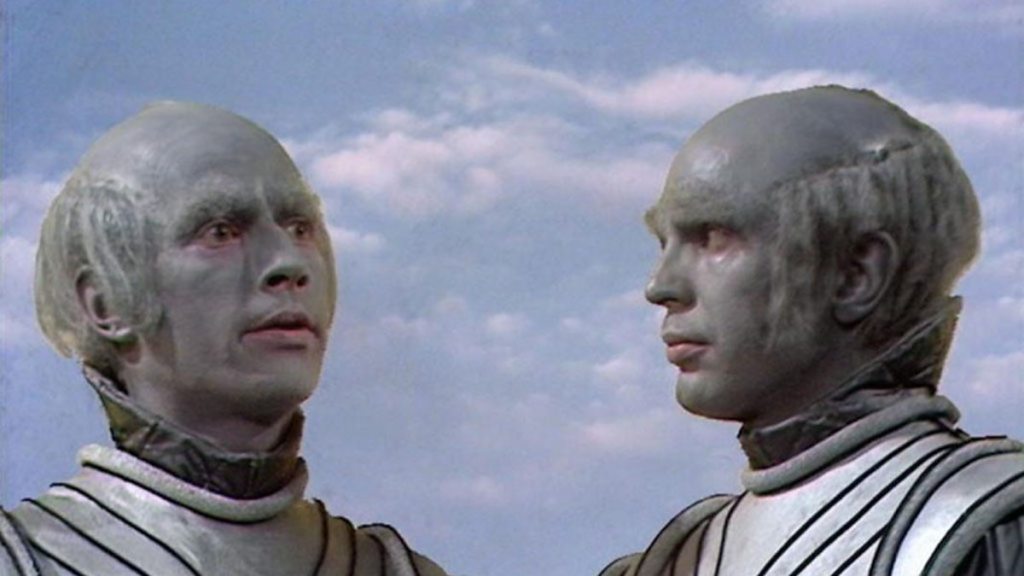
In which the Doctor and Jo find themselves on the SS Bernice in the Indian ocean, trapped in a loop where the crew of the ship repeat their actions over and over again. Meanwhile on Inter Minor, Vorg and Shirna are trying to get their Miniscope show through the incredibly suspicious authorities.
I don’t think it’s a controversial opinion to say that Season 10 was brilliant, and that the Doctor’s ability to pilot the TARDIS being restored in ‘The Three Doctors’ is a key part of that. This is the first story following that, and so the show has a double whammy of travelling to the past and to an alien planet. The Doctor and Jo’s arrival on the SS Bernice is a sleight of hand, gradually revealing new mysteries until you start to realise how it’s connected to the action on Inter Minor.
Inter Minor’s grey-skinned bureaucrats – played with haughty relish by Who stalwarts Michael Wisher, Peter Halliday and Terence Lodge – are both simultaneously instigating their own internal power struggles while forbidding Vorg and Shirna from bringing their travelling show onto the planet, featuring a Miniscope – something like a TV where you can watch various creatures living and fighting in miniaturised landscapes within the device. Their carny-inflected dialogue and garish outfits suggest them as not only reflections of the Doctor and Jo but of Robert Holmes and the production team trying to work with BBC officials. The standout dialogue from this section is when Vorg insists ‘Our purpose is to amuse. Simply to amuse. Nothing serious, nothing political.’
So, you have an unfolding mystery, with all the great dialogue you’d expect from Bob Holmes, with a heady sci-fi concept that is continually ripping the piss out of the BBC and providing a commentary on the show itself (‘The Drashigs. My little carnivores. Ho, ho, they’re great favourites with the children, you know, with their gnashing and snapping and tearing at each other.’). It’s relentlessly imaginative, playful, and quite simply the best thing the Pertwee era ever produced.
3. The Robots of Death (Season 14, 1977)
Written by Chris Boucher. Directed by Michael E. Briant.
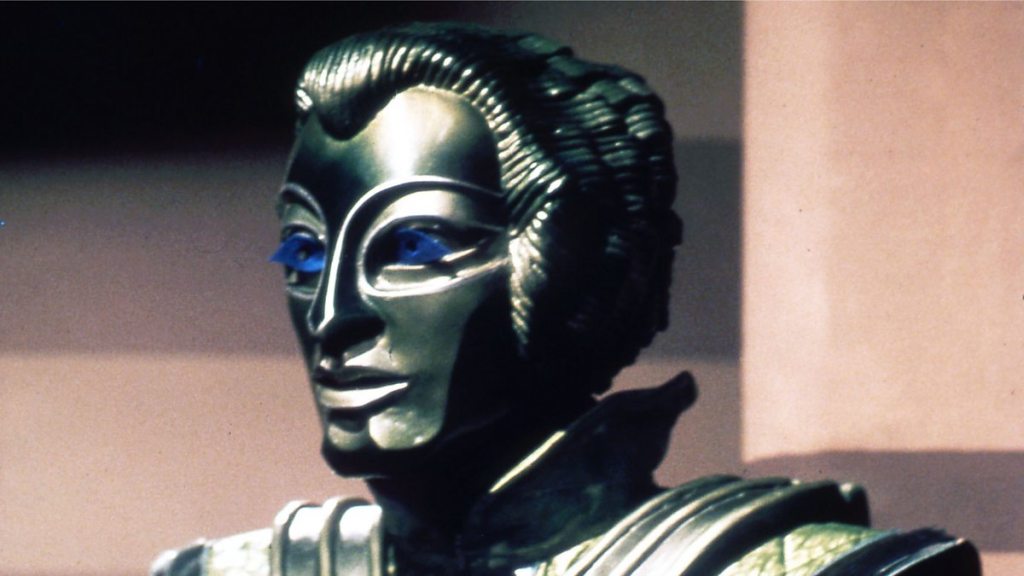
In which the Doctor and Leela arrive on a huge Sandminer vessel where someone is strenuously challenging Asimov’s First Law of Robotics.
Remember what we were saying about supporting casts being rich enough to shore up their own stories? Well, there’s a whole range of spin-off books and audioplays from this story. The crew of the Sandminer are a clash of conflicting personalities who are already getting on each other’s nerves, and the Doctor and Leela arrive just as the murders begin to raise the pressure further. This isn’t a Whodunnit, so much as a How? We know from the first murder that the robots are the killers, with their red blazing eyes and hearts full of neutrality, but we aren’t sure how they’ve managed to break their programming.
The robots also have character, which adds another level to the story. The detached calmness with which they act, speak and murder is chilling, and then we have D84: the robot spy who befriends the Doctor, and whose self-sacrifice is especially sad for someone whose face doesn’t move. The fact that the D class of robots (‘D for dumb. It cannot speak’) are all painted black is a very pointed and uncomfortable choice.
Amid some incredibly intense robot attacks, losses of sanity and very satisfying door-entry-coder noises, we have a story that looks fantastic (barring the robot’s shoes, but then the show has always struggled with robotic footwear), with visuals that sear themselves onto the brain (the robots in general, but especially the warped silhouette of a robot pawing at the bridge door trying to break in) and contains Leela’s dismissal of dimensional transcendentalism as silly.
A special mention to the insults, too. The Doctor’s ‘You know, you’re a classic example of the inverse ratio between the size of the brain and the size of the mouth’ is currently the world’s longest and most unwieldy zinger, but my personal favourite is Borg’s response to ‘Would you like a jelly baby?’ which is to yell ‘SHUTUP’ and smack the packet out of the Doctor’s hand. Brevity, kids, that’s the key.
2. The Ribos Operation (Season 16, 1978)
Written by Robert Holmes. Directed by George Spenton-Foster.
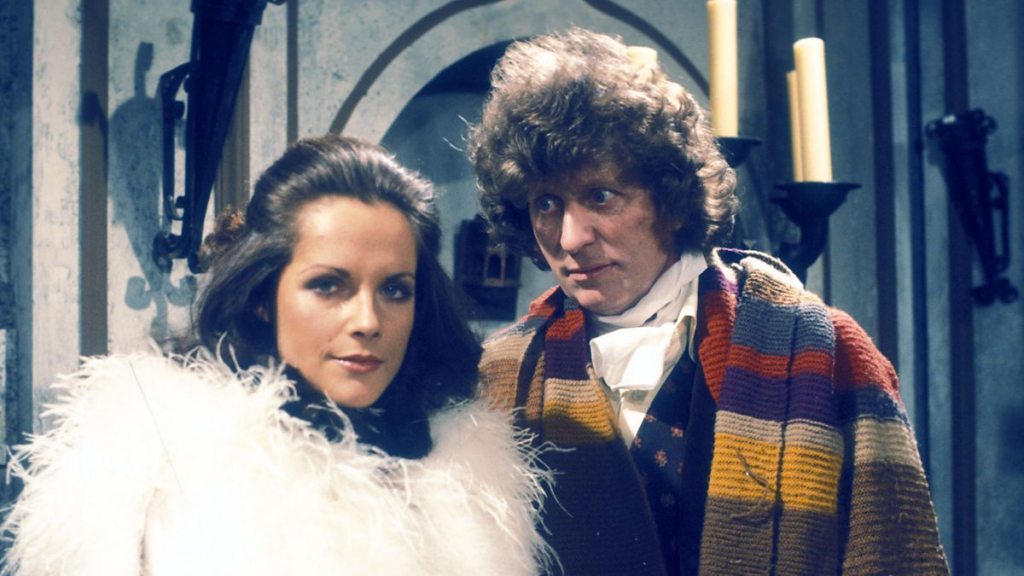
In which the Doctor is summoned by the White Guardian – one of two opposing entities representing stability and chaos – to go on a quest for the Key to Time. This takes him and his new assistant Romana – fresh out of the Time Lord Academy – to Ribos, where he meets some con-men and a deposed dictator, the Graff Vynda K.
Robert Holmes has a reputation for dark comedy and cynicism, being angered enough by bureaucracy (caused by nationwide or internal BBC politics) to base a whole story on it (Season 15’s ‘The Sunmakers’). There have been strong arguments made that he wasn’t above sending the show up, responding to specific production requests by undermining them (this is what most redemptive readings of ‘The Two Doctors’ focus on, for instance). Applying that assumption to ‘The Ribos Operation’ works: Holmes read producer Graeme Williams’ frankly bizarre outline for The Key to Time storyline and decided to move away from a battle of opposing godlike forces, instead writing a tale about con men and heretics on a backwater planet.
Given Russell T. Davies’ 2003 pitch document specified human interest stories – as opposed to planets of people we don’t really care about – it’s notable that ‘Ribos’ goes out of its way to address the contrast between the ruled and the rulers, with the White Guardian’s abstractions, the Graff Vynda K’s petty megalomania, and the scenes with Binro the Heretic (an outcast from Ribos’ society). With Garron and Unstoffe (a ripe Iain Cuthbertson and sometime Henson workshop puppeteer Nigel Plaskitt) and the Graff with his loyal henchman Sholakh, Holmes uses double acts as mirrors of the Doctor and Romana (Garron and Unstoffe are more obviously akin to the Doctor and Romana, the antagonists’ relationship reflects the loyalty of companions like Sarah and Jo). The Doctor’s new companion definitely has the academic smarts, but is naïve in the ways of the universe (another contrast between more abstract knowledge and things that actually impact people’s lives).
So it’s clever. Lovely. Is it actually entertaining? Oh hell yes. The entire story is worth it purely for the scene where the Doctor steals the Graff’s glove. Cuthbertson’s Garron a garrulous swaggering presence who makes Tom Baker raise his game. Unstoffe is the story’s heart, its moral conscience. The Doctor and Romana, by virtue of this quest for the Key to Time, are at a remove from Unstoffe and Binro, which begs the question of what they’d do if they arrived here without a pre-appointed task. The bad guys are vainglorious empire-builders who take themselves too seriously. ‘The Ribos Operation’ is an endlessly rewatchable crime-caper that defines what the Doctor stands for, and what he should stand for.
1. The Ark in Space (Season 12, 1975)
Written by Robert Holmes. Directed by Rodney Bennett.
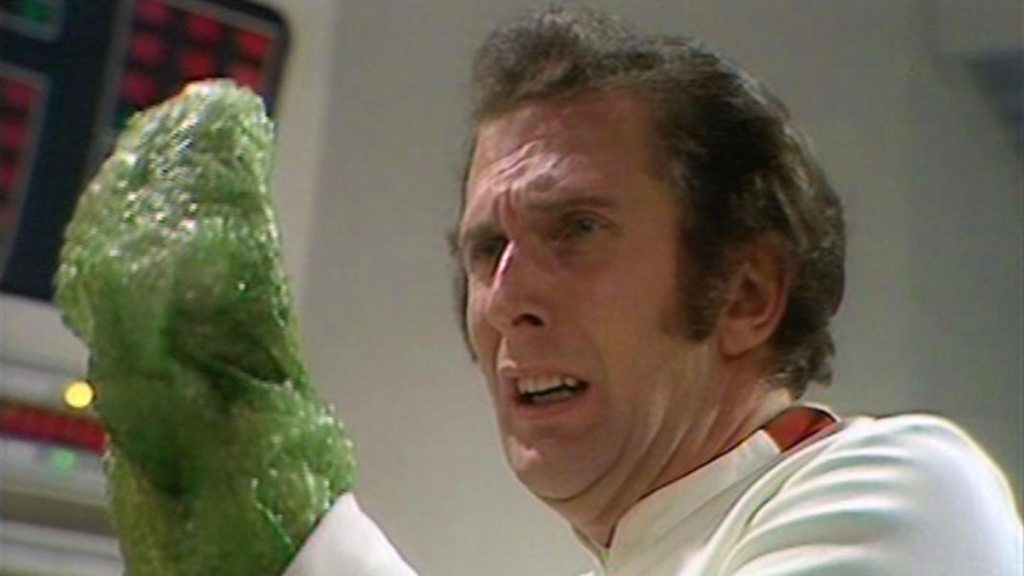
In which the Doctor, Sarah and Harry land on a space station in the far future, and find a group of humans cryogenically stored to escape solar flare activity destroying life on Earth. The only problem is, something has got into the ark and its children are hatching…
It never gets tiring reminding people that this is essentially Alien for children, with the insectoid Wirrn based on wasps that lay eggs in other animals. A lot of the make-up and costuming is based around bubble-wrap, which was not ubiquitous at the time, but despite this, some of the visuals really land (the Wirrn grubs look disgusting) and the acting manages to sell the concept when it doesn’t. There’s a definite weight to the horror in this story, an immediate sense of how the show would be moving forward. The cosiness is dialled down, but crucially still present, and the peril levels raised.
Watching this outside of broadcast, it’s hard to truly appreciate how markedly different it is to ‘Robot’, the story that preceded it. Tom Baker’s first story was the work of the outgoing production team of Barry Letts and Terrance Dicks, whereas this is the first story of the new duo Philip Hinchcliffe and Robert Holmes. The first episode features just the Doctor, Sarah and new companion Harry looking around a space station that seems to be trying to kill them. It’s like a William Hartnell story rather than the familiarity of UNIT.
From this starting point the story moves through possession horror to base under siege, the stakes as high as the existence of the human race. There’s one scene in particular which combines the two: the leader of the revived humans, Noah, is initially a cliched Doctor Who base commander accusing the TARDIS crew of sabotage and of being ‘regressive’ elements. The guy’s a dick, basically. Then he gets attacked by a Wirrn grub and starts transforming into one himself, and the scene where he sees his green, bubble-wrap covered hand could be one of those embarrassing old special effects clips out of context, but then a recording of the presumably long-dead Earth President starts playing, addressing the humans on the Ark. It’s a voice from the past, reminding them of the importance of their task and what they’ve lost, just as Noah is losing his humanity. Kenton Moore acts the flip out of this scene, the full weight of his situation is absolutely clear.
The original run of Doctor Who didn’t go for pathos as often as the post-2005 version does, but there are a dozen or so moments like this that are among the most powerful the show has ever produced (and from the pen of arch-cynic Robert Holmes too) with Tom Baker immediately showing the dramatic range of his strangeness. ‘The Ark in Space’ is a story of unrelenting horror and attack, leavened with some memorable scenes, monsters, set designs and character moments (there’s a lot to pick from, but I’m a big fan of Harry’s nonchalant ‘We found it in a cupboard’ response to the question of why there’s a colossal alien wasp lying dead on the floor), and one of the masterpieces of Doctor Who. If you can appreciate the many tragedies of a guy with bubble wrap on his hand realising he might have doomed humanity, then this is clearly the show for you.
